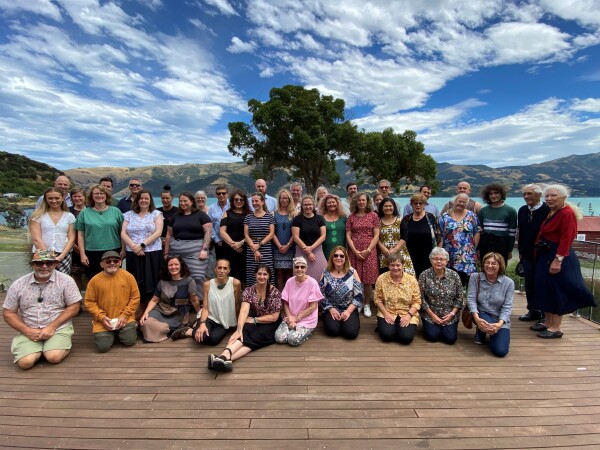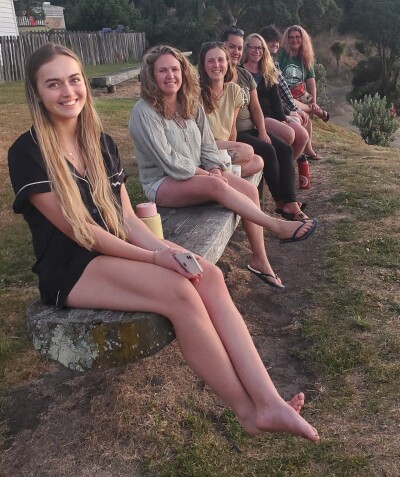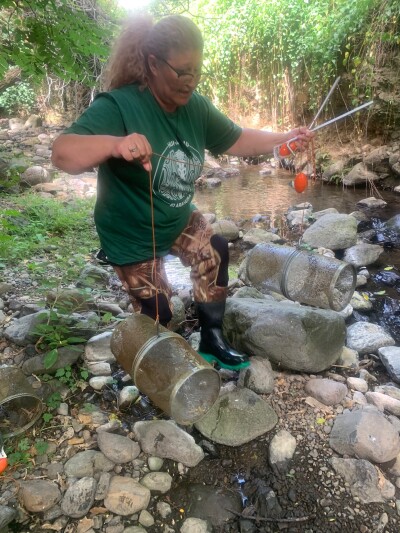Ōnuku climate change wānanga
Jan 31, 2024
By Daniel Nielsen
The Climate Change Adaptation Wānanga at Ōnuku Marae took place in sweltering heat; a stark reminder of the kaupapa at hand.

Attendees on the first day of Te Kori a te Kō.
Home to Ngāi Tārewa and Ngāti Īrakehu, Ōnuku hosted three days of workshops, expert panel discussions, and activities.
Ōnuku chair Rik Tainui says the wānanga, titled Te Kori a te Kō, was a great success.
“We had whānau, community representatives, climate science experts, and local government folks all in the same place, talking about what we can do now to enhance our future.
“Te Kori a te Kō lined up beautifully with our iwi whakataukī – Mō tātou, ā, mō kā uri ā muri ake nei (for us and our children after us),” Rik Tainui says.

Ōnuku rangatahi chilling with some awesome ecologists.
Organiser and Te Taiao Portfolio Manager for Ōnuku, Debbie Tikao says the idea for the wānanga sprung from wanting a mahinga kai management plan for Akaroa Harbour in 2019.
“Through that mahi, we realised we need to think bigger so we expanded to integrate climate change.”
The three-day event kicked off on Friday 19 January with kōrero designed to develop an understanding of how climate change will affect Akaroa Harbour, Ōtautahi, and communities. Its purpose was to lay the groundwork to prepare whānau for challenges ahead.
Debbie Tikao says a lot is already being done locally to mitigate and adapt to climate change, citing kelp farming exploration in the harbour, reforestation on Banks Peninsula, and education initiatives.
“Te Kori a te Kō is about what’s next,” she says.
The first day of the wānanga featured a panel of experts: Environment Canterbury (Ecan) chief scientist Dr Fiona Shanhun, coastal geomorphologist Sonny Whitelaw, Ecan principal advisor (Natural Hazards) Justin Cope, and Christchurch City Council’s coastal adaptation principal advisor Tom Simons-Smith.
Antarctica scientist Dr Fiona Shanhun (image 2.) spoke about how the icy continent connects to New Zealand, and the rest of the world for that matter. Temperatures, wind, animal migration – Antarctica has a significant impact on all of these.
“If all the ice melted, the sea would rise 60 metres,” she says.
Tom Simons-Smith spoke about the impact of sea level rise in Ōtautahi, showing data visualisations of how sea level rise would flood areas such as Sumner and Redcliffs. And Sonny Whitelaw explained the marine heatwaves we have experienced in recent years will become normal by the end of the century.
It was alarming.

The Great Stream Off Challenge involved sampling water quality, hunting for macroinvertebrates, pulling up nets, and checking out the taonga species.
Debbie Tikao is urging optimism despite the depressing reality.
“It’s important we can visualise the potential impacts such as residential areas being inundated but equally, we have to be buoyant about our ability to mitigate and adapt.”
She says the whānau adaptation challenge led by rangatahi was a real highlight of the wānanga.
The aim of the challenge was to get whānau thinking about what they can do at home to prepare for our changing environment and how they can reduce their own carbon footprint.
The challenge was “fun, insightful, and highly competitive”, says Debbie, resulting in plenty of outside-the-box ideas.
Another high of the three days was the ‘Stream Off’ activity on the second day. This involved testing water quality and identifying taonga species in three local streams – Pakai-ariki (Aylmers Stream), Takamatua, and Te Wai iti (Belgueri). A team of advisors and ecologists from Ecan and EOS Ecology led the activity.
Rangatahi climate change leader Amiria Tikao says she loved the wānanga, especially the stream activity.
“We learned so much, I had no idea there was so much life in the streams.”
It turns out Pakai-ariki is the healthiest of the three streams, with an abundance of mahinga kai and the healthiest water.
“It was full of native manu and had a near-complete canopy cover,” Amiria Tikao says.
The final day of Te Kori a te Kō started a hīkoi through the Garden of Tāne and a kōrero from Ōnuku education portfolio leader Jess Rogers about the creation story and the role of Tāne Mahuta. This was followed by a walk through Tākapūneke with a kōrero from Adrian Boardman.
If your Rūnanga is wanting any support from Te Rūnanga o Ngāi Tahu in relation to climate change adaptation planning, please contact [email protected].